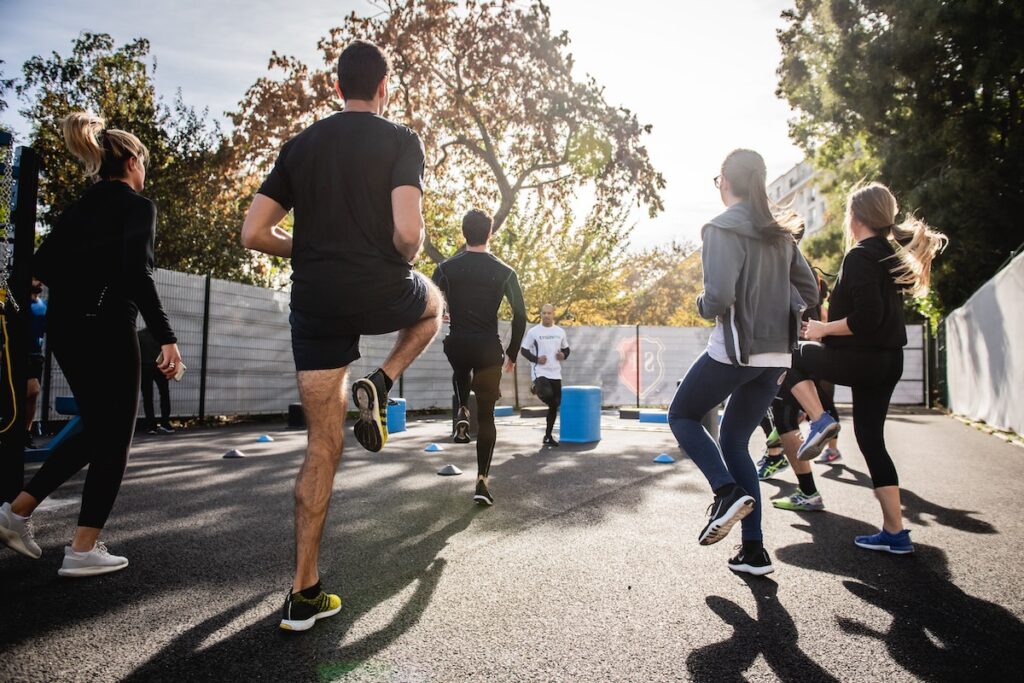
The mortality gap between people with severe mental illness (SMI) and the general population is about 15-20 years (see Equally Well).
An increase in exercise is one of the modifiable factors that could help narrow this gap, improving physical and mental wellbeing as well as overall quality of life.
High Intensity Interval Training (HIIT) consists, typically, of 10-25 minutes of intense repetitious exercise (30 seconds to 4 minutes each) interspersed with lighter exercise or rest. HIIT is known to be beneficial to the physical and mental health of the general population, with limited evidence suggesting the same applies for people with SMI, but there is a paucity of data specifically assessing benefits for psychiatric inpatients.

What do inpatients, carers and staff think about the idea of having HIIT sessions in psychiatric hospitals?
Methods
In their 2021 article, Martland, Gaughran, Stubbs and Onwumere explain that there is a knowledge gap in the literature about people’s opinions of the idea of providing HIIT sessions in a psychiatric hospital setting. They aimed to find the answer by asking inpatients, their informal/family carers and hospital staff.
Participants came from a large London NHS mental health service which included national specialist services as well as mental health provision for people living in four boroughs of London. People were made aware of the research through advertising posters and presentations at ward community meetings (asking for inpatients with a severe mental health condition), business meetings (asking for staff working in psychiatric inpatient care) and carer forums (asking for self-identified informal carers supporting someone with lived experience of severe mental health problems). All participants had to be 18 or older, with sufficient English language skills to be able to participate in a focus group and able to provide written consent.
Patient focus groups were held on a ward with a staff member present but not participating. The carer and the staff focus groups were in “various settings” within the NHS trust and King’s College London Institute of Psychiatry. The 1-hour sessions were audio-recorded and transcribed verbatim unless permission to record was not provided in which case a researcher made verbatim notes. They began with a definition of HIIT, a description of the objectives of HIIT and a video demonstrating a session. An interview schedule of open questions followed. It was developed from a literature review and consultation with clinical experts. It focussed on seeking opinions about setting up a HIIT intervention on a ward and perceived barriers to, and enablers of, exercise. The groups ended at the point of data saturation.
After the groups, each recording was listened to at least twice, then data was analysed using thematic analysis guidelines.
Results
There were 3 inpatient focus groups (13 people), 2 for carers (15 people) and 2 for staff (11 people). 1 patient felt unable to participate in a group and was interviewed separately.
The researchers were unable to ascertain how many potential participants decided not to take part, but they gathered information on reasons cited; lack of motivation or time to attend a group and no interest in physical activity.
Two main themes emerged, they were;
- Positivity towards the idea. All groups thought the idea was good, with carers noting the importance of being fit and that participation as an inpatient might be an introduction to being more active in general. All groups thought it would relieve boredom and that the short duration would mitigate against issues that can affect people who are acutely mentally ill such as amotivation and limited concentration.
- Implementation concerns, with 3 sub-themes:
- Motivation. There were concerns that patient amotivation might affect the success of starting any sessions, especially among those who are older, experiencing medication side-effects or who do not associate exercise with positive memories. Several patients thought it might be better to set up HIIT in the community and carers suggested if started on the ward there should be a way for sessions to continue after discharge. There were mixed views about whether individual or group training would be more motivating, and suggestions to help motivation included using music and encouragement.
- Patient safety. Carers and staff thought it important to consider medical history and physical health checks before participation, and that intensity and duration of training should be reduced but, generally, patients disagreed and thought it should be up to themselves to decide whether to participate and, if there were health issues, they could adapt their pace. Some participants from each group thought HIIT would be unsuitable for the most severely unwell.
- Logistics. Carers and staff had concerns about whether patients would have suitable shoes and clothes and that if the sessions were off the ward there may be pragmatic barriers relating to leave arrangements for patients and staff capacity. Patients did not raise any of these concerns in their groups.

Participants shared the challenges of implementing HIIT in inpatient settings, including the motivation of people on medication and patient safety.
Conclusions
The authors concluded:
The introduction of HIIT for inpatients with SMI was actively endorsed by patients, carers and healthcare professionals.

In this qualitative study, the introduction of High Intensity Interval Training for inpatients with severe mental illness was actively endorsed by patients, carers and healthcare professionals.
Strengths and limitations
The qualitative method used by the authors was appropriate as their aim was to seek the subjective perspectives of potential stakeholders who would be involved should a HIIT programme be provided in a psychiatric hospital, and their data collection method is clearly described. What is not clear, however, is how much knowledge the participants in the groups of carers had of inpatient units because, unlike for the staff and patient groups, there was not an explicit requirement that their experience of caring for someone with severe mental health problems included that person having been in hospital, meaning they might not have been the most appropriate set of carers for sharing their opinion on this topic. There was a reasonable mix in the staff group which included health care assistants, nurses and a psychiatrist, but no psychologists, occupational therapists, ward managers or physiotherapists. There were (non-participant) staff at the patient group to support them, but this could have influenced what the patients chose to say.
The authors identified two study limitations, acknowledging that there was the possibility of missed data due to not audio recording patient focus groups and that the views gathered may not have been representative of those who did not attend (who may have less interest in and a different attitude towards exercise). However, the interpretation of the study is hampered by some missing details.
- Firstly, it wasn’t clear what type of HIIT was discussed. HIIT protocols can vary greatly in terms of the type of exercise (e.g., running versus cycling), duration of sessions (e.g., 10 minutes [Metcalf et al., 2012] to 38 minutes [Wisloff et al., 2007]), and intensity of effort (e.g., ‘all-out’ sprints versus submaximal exercise at ~95% peak heart rate), and it would be inappropriate to consider all protocols to be equally feasible and acceptable.
- Secondly, the study didn’t provide details of the participants’ age or exercise history. This is important because young and highly active individuals might have very different perceptions to older and highly sedentary ones. Related to this, the authors highlight the possibility of participants having a greater interest in physical activity and exercise than non-participants.
- Thirdly, some items of the ‘Consolidated criteria for reporting qualitative research’ (COREQ; Tong et al., 2007) were not adequately reported; for example, the researchers’ credentials, occupation, experience and training, which would help readers to assess how these factors might have influenced the teams’ interpretations and conclusions.

HIIT protocols vary in duration, type of exercise and number of sessions, so what would be effective for inpatient settings is yet unknown.
Implications for practice
The authors compared their findings with pre-existing evidence, explaining that the feedback they received was in keeping with other research into psychiatric patients’ beliefs and concerns about exercise programmes in clinical settings. They acknowledged that there remains a gap in the evidence about what the implications of introducing HIIT could be in terms of impact on carer-patient and patient-staff relationships and also in terms of possible benefits of the training on staff and carers. This was because these topics were not considered within the focus groups. They recommended that the identified “motivational, safety and practical” barriers should be taken into consideration before implementing a new intervention for inpatients.
The paper does not discuss whether the findings could be transferrable and, without information on the details we discussed above, it is difficult for the reader to conclude how likely it is that the themes emerging from these focus groups would apply for inpatients, their carers and staff, in other psychiatric settings. Almost 40% of the inpatients in this study were from mixed sex wards, we would be interested to know if this bore any influence on the participants’ views and whether opinions would have been different if the focus groups’ experience was only of single sex wards (elsewhere in the UK, there are mental health services with no mixed sex wards).
Overall, the study provides interesting insights into stakeholders’ perspectives of HIIT in psychiatric inpatient settings, but the question remains about how we find out the views of stakeholders with no interest in exercise.

The findings from this study are in keeping with other research, but how do we gather the views of stakeholders with no interest in exercise?
Statement of interests
SK contributes to a Healthy Weight Management research group which author Brendon Stubbs is also a member of.
SK and GT are leads for PASMI, the Physical Activity in Severe Mental Illness research group.
GT is a Co-Investigator on the NIHR-funded SPACES programme, which author Brendon Stubbs is also a Co-Investigator of, and SK is Principal Investigator for her NHS trust on the associated RCT.
Links
Primary paper
Martland R, Gaughran F, Stubbs B, Onwumere J. (2021) Perspectives on implementing HIIT interventions for service users in inpatient mental health settings: A qualitative study investigating patient, carer and staff attitudes. Journal of Affective Disorders 2021 283 198-206.
Other references
Wisløff U, Støylen A, Loennechen JP. et al (2007) Superior cardiovascular effect of aerobic interval training versus moderate continuous training in heart failure patients: a randomized study. Circulation 2007 115(24) 3086-3094.
Metcalfe RS, Babraj JA, Fawkner SG, Vollaard NB. (2012) Towards the minimal amount of exercise for improving metabolic health: beneficial effects of reduced-exertion high-intensity interval training. EJAP 2012 112(7), 2767-2775.
Tong A, Sainsbury P, Craig J. (2007) Consolidated criteria for reporting qualitative research (COREQ): a 32-item checklist for interviews and focus groups. International Journal for Quality in Health Care 2007 19(6), 349-357.
Photo credits
- Photo by Malik Skydsgaard on Unsplash
- Photo by Gabin Vallet on Unsplash
- Photo by Tegan Mierle on Unsplash
